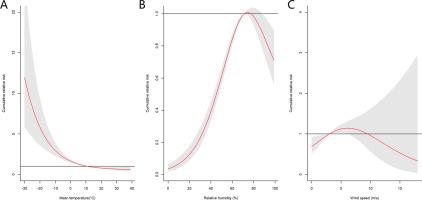Science of the Total Environment ( IF 8.2 ) Pub Date : 2020-11-23 , DOI: 10.1016/j.scitotenv.2020.143783 Cui Guo 1 , Yacong Bo 1 , Changqing Lin 2 , Hao Bi Li 3 , Yiqian Zeng 1 , Yumiao Zhang 2 , Md Shakhaoat Hossain 2 , Jimmy W M Chan 2 , David W Yeung 4 , Kin-On Kwok 5 , Samuel Y S Wong 1 , Alexis K H Lau 6 , Xiang Qian Lao 1

|
Novel corona virus disease 2019 (COVID-19), which first emerged in December 2019, has become a pandemic. This study aimed to investigate the associations between meteorological factors and COVID-19 incidence and mortality worldwide. This study included 1,908,197 confirmed cases of and 119,257 deaths from COVID-19 from 190 countries between 23 January and 13 April, 2020. We used a distributed lag non-linear model with city-/country-level random intercept to investigate the associations between COVID19 incidence and daily temperature, relative humidity, and wind speed. A series of confounders were considered in the analysis including demographics, socioeconomics, geographic locations, and political strategies. Sensitivity analyses were performed to examine the robustness of the associations. The COVID-19 incidence showed a stronger association with temperature than with relative humidity or wind speed. An inverse association was identified between the COVID-19 incidence and temperature. The corresponding 14-day cumulative relative risk was 1.28 [95% confidence interval (CI), 1.20–1.36] at 5°C, and 0.75 (95% CI, 0.65–0.86) at 22°C with reference to the risk at 11°C. An inverse J-shaped association was observed between relative humidity and the COVID-19 incidence, with the highest risk at 72%. A higher wind speed was associated with a generally lower incidence of COVID-19, although the associations were weak. Sensitivity analyses generally yielded similar results. The COVID-19 incidence decreased with the increase of temperature. Our study suggests that the spread of COVID-19 may slow during summer but may increase during winter.
中文翻译:

190 个国家的气象因素和 COVID-19 发病率:一项观察性研究
2019 年新型冠状病毒病 (COVID-19) 于 2019 年 12 月首次出现,现已成为一种流行病。本研究旨在调查全球气象因素与 COVID-19 发病率和死亡率之间的关联。这项研究包括 2020 年 1 月 23 日至 4 月 13 日期间来自 190 个国家的 1,908,197 例确诊病例和 119,257 例死亡病例。我们使用具有城市/国家级随机截距的分布式滞后非线性模型来调查 COVID19 之间的关联发病率与每日温度、相对湿度和风速有关。分析中考虑了一系列混杂因素,包括人口统计、社会经济学、地理位置和政治策略。进行敏感性分析以检查关联的稳健性。COVID-19 发病率与温度的关联性强于与相对湿度或风速的关联性。COVID-19 发病率与温度之间存在负相关关系。参考 11 天的风险,5°C 时相应的 14 天累积相对风险为 1.28 [95% 置信区间 (CI),1.20–1.36],22°C 时为 0.75 (95% CI,0.65–0.86)。 °C。相对湿度与 COVID-19 发病率之间存在反 J 形关联,风险最高为 72%。风速较高与 COVID-19 发病率普遍较低相关,尽管这种关联较弱。敏感性分析通常得出相似的结果。随着气温升高,COVID-19发病率下降。我们的研究表明,COVID-19 的传播在夏季可能会减慢,但在冬季可能会增加。











































 京公网安备 11010802027423号
京公网安备 11010802027423号